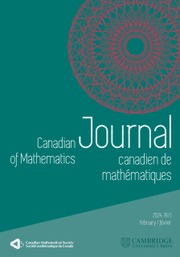Article contents
Completions of Quadrangles in Projective Planes II
Published online by Cambridge University Press: 20 November 2018
Extract
This viewpoint of studying projective planes was given in my previous paper (12). It is discussed in other papers: Hall (4, 6, 7), Maisano (16), Lombardo-Radice (14, 15), Wagner (19). In particular, we consider how to make identifications in the free plane, or how identifications are forced when one begins with a non-degenerate quadrangle and makes free extensions of this quadrangle of a known plane. We shall continue to develop this topic using the notations and definitions of the previous paper (12). We consider the number of subplanes of certain planes, finding exact values in the cases of the known order-nine planes, and deriving a lower bound in a general case. We prove a theorem concerning the structure of all singly generated planes. We give an example to show that this structure is not definitive. Finally, we prove that a specific Walker-Knuth plane is singly generated.
Information
- Type
- Research Article
- Information
- Copyright
- Copyright © Canadian Mathematical Society 1965
References
- 1
- Cited by

